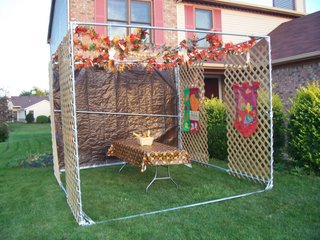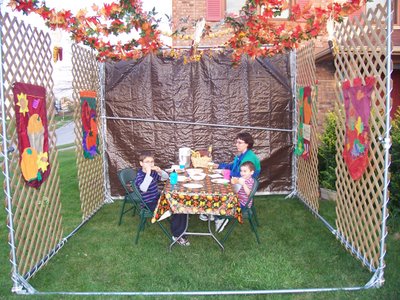For those of you new to Jewish holidays, Sukkot is a harvest holiday that occurs 9 days after Yom Kippur. On Sukkot we celebrate the harvest and commemorate the 40 years the Israelites wandered in the desert by building temporary structures called sukkot (singular sukkah), booths that are decorated with fruits, gourds, leaves, and well, pretty much anything that at least resembles nature.
There are a few rules for making a sukkah kosher, one of which is that you must be able to see the stars through the roof. Another rule is that the sukkah must be a TEMPORARY structure. Therefore, poking holes in the roof of your garage does not make a kosher sukkah unless you then completely disassemble the garage after Sukkot. It’s possible to do it, but not recommended.
Sukkot is now over, but the Quest for the Perfect Sukkah continues. We’ve been on this quest for six years.
Note, I didn’t say the biggest sukkah, nor the strongest sukkah, nor even (thankfully) the prettiest sukkah. I said the Perfect Sukkah. The Perfect Sukkah is an elusive concept, a combination of aesthetics, strength, and re-usability at a price that won’t require you to put your mortgage lender on speed dial.
It all started back in Minnesota, six years ago, when we first bought our townhouse. We looked out on our tiny plot of yard and decided that the best way to celebrate our escape from apartment life was to build our own sukkah. So, on the first day of Sukkot we scribbled out a simple design that made most shantytowns look like the Trump Towers, and drove to Home Depot. “We’ll need wood,” we decided. “Probably some 2x4s. Oh, and nails. And big cement blocks to hold up the corner posts.” Loaded down with about $50 worth of merchandise, we drove home and set upon hammering boards together.
Lesson # 1: Hammering 2x4s together is a BAD idea unless you have a saw horse, several clamps, and a sound-dampening room.“KA-PAH! KA-PAH! KA-PAH!”
The ‘call of the inept’ echoed around our cul-de-sac. I pounded on the nails, hoping they would hold the 2x4s together. They didn’t.
“KA-PAH! KA-PAH! KA-PAH!”
About this time, many of our new neighbors came out of their houses, attracted by the ruckus.“What’cha doin’?” one of them asked us? So, as I pounded unsuccessfully on the wood, Shirah explained the holiday of Sukkot complete with its rich history and beautiful traditions.
“KA-PAH! KA-PAH! KA-PAH!”
“Hmm...,” she said. “Have you tried drilling holes and using screws instead of nails?”
Shirah and I looked at each other. Screws? What a novel idea. So, one more trip to Home Depot later, we set about the project again, drilling holes, screwing boards together, getting splinters, and loudly taking the Lord’s name in vain. Finally, we propped up our minimalist sukkah, set the poles in the large cement blocks, and covered the entire thing with chicken wire. It swayed uneasily. As we looked at it proudly, one of our neighbors tentatively asked the question we would hear every year, “So, this is a temporary thing, right?”
Fast forward two years to 2003 (5764). After moving to Indiana, we now had a single-family dwelling with our own yard. “Let’s put up a sukkah,” we decided. However, this time, we had learned the lessons from our last attempt.
Lesson #2: Don’t use cement blocks or chicken wire for a sukkah. Ever.Lesson #3: Spend more than 30 seconds planning out your design.This time we were prepared. We planned our sukkah carefully, we calculated the amount of lumber we needed, and we studiously avoided buying any more cement blocks or chicken wire, knowing that they would only sit in our yard for years to come serving no other purpose than to make mowing the lawn a painful experience.
Shirah went to Home Depot, Lowe's, and Menards to compare prices on lumber. While searching for the necessary hardware, she ended up explaining the sukkah to each salesman. If you’ve never tried to explain a sukkah to a goyische hardware store clerk, we highly recommend you try it at least once in your lifetime. They all looked at her blankly. “You want to do what?” She showed them each the drawing and explained that YES she did want the whole thing made out of wood, and YES it was a temporary structure, and NO she didn’t want to glue it together with Elmer’s wood glue.
$100 worth of lumber and hardware later, we started to set up the sukkah. We used 4x4s for the corner posts, 2x4s for the cross beams, and wooden lattice for the roof. We bolted everything together with big nuts and bolts which had the advantage of easy construction but the disadvantage of slight instability.
I have decided that one of the requirements for making a sukkah kosher is that blood must be drawn at some point. Either that, or you must smash your thumb with the hammer at least twice. While I nursed my hand, Shirah explained the rich history of Sukkot to our neighbors. “So, it’s a temporary thing, right?” they asked.
The sukkah held for the full week of Sukkot.
Fast forward one year to 2004 (5765). All the lumber from the previous year’s sukkah had been neatly stored in the corner of our garage. We got it out and started to put up the sukkah in our front yard. My mother-in-law was visiting, so we pulled her into the project.
Lesson #4: In Indiana, 2x4s that are not stored in hermetically sealed containers will warp.My mother-in-law, my wife, and I stared at the twisted wood thoughtfully, then decided to try putting the sukkah together anyway. Some boards bolted together nicely. Some...didn’t. When we finished, we had a couple of 2x4s sticking out at odd angles while the rest of the sukkah looked like something from a Dr. Suess book.
Would you eat it in a sukkah? Would you smoke it in a hookah?After our fit of giggles subsided, we were off to Home Depot to buy $50 to $75 of replacement lumber. Again, the sukkah held. Just barely, but it held.
Fast forward one more year to 2005 (5766). After replacing the newly warped wood from the previous year’s sukkah, we decided to revisit the whole design. We sketched and resketched and argued and debated until we finally came up with a new design that used corner brackets instead of nuts and bolts to hold the crossbeams together. This had the advantage of not tearing into the wood like bolts did. It had the added advantage of extra stability. It had the slight disadvantage of permanence.
Lesson #5: Before screwing metal plates onto wood, soap or wax the screws so they don’t get stuck in the wood forever.
When I tried to disassemble the sukkah after Sukkot, I discovered that the wood had swollen around many of the screws in the corner brackets, so that they now refused to come back out. After confirming that the children were safely out of earshot, I mumbled a string of obscenities and finally ended up stuffing a lot of 2x4s in the corner of the garage with the twisted wreckage of the corner brackets still tightly adhered.
Fast forward to this year (5767). I had had enough with warped wood, corner brackets, and heavy 4x4s. It was time for a complete paradigm shift. I decided to make the sukkah frame out of metal.
“How about we just buy a sukkah kit?” my wife pleaded.
“No,” I said. “We can do this. It will work. Trust me.”
She managed a faint smile and started repeating our marriage vows to herself like a mantra.
A month before Sukkot, I started my research. Galvanized steel pipe seemed the way to go. One Website recommended that I go to an awning supply store to buy all the connecting hardware. This seemed like a great idea until I tried to find an awning supply store that would sell me awning connectors. Such a store didn’t seem to exist in Indianapolis.
It was back to Home Depot. I flagged down a store clerk and showed him my new drawing. Skipping past the discussion of Sukkot’s rich history, I cut to the chase. “OK, I want to build a cube out of galvanized steel pipe. It should be 10 feet by 10 feet. It will be temporary, but it has to stand up for a week. What connectors should I use?” My goyische sales clerk thought about it. “I don’t think anything like that exists,” he stated.
Lesson #6: If the first hardware store clerk doesn’t give you the answer you want, find one who will. Hardware fittings are infinite. Sales clerk experience is finite. Sales clerk creativity is infinitesimal.I must have gone back and forth to Lowe’s and Home Depot a half a dozen times to find all my materials. In the end, we used 1 3/8” fencing post with a variety of fencing post connectors. We borrowed a friend’s reciprocating saw to cut the metal posts down to size, and used construction-grade epoxy to fasten fencing caps to the ends of the cross beams. The front and back walls of the sukkah were squares made by fitting 4 fencing posts into elbow joints. The walls of the sukkah were made by attaching fencing posts from the front square to the back square by way of special fencing hardware that was presumably not originally intended for sukkah-use. If you are interested, I will send you our final design. I think I scribbled it on a napkin somewhere.
On the first day of Sukkot, we set about putting together all the pieces. Coincidently, my in-laws had come to visit that very same day.
“They’re not here to help with the sukkah,” my wife warned. “They’re just visiting.”
I laughed. They made the mistake of visiting on the day we’re building a sukkah. Of course they’ll help with the sukkah.
Lesson #7: Brilliant designs will be thwarted by sub-par materials. Lesson #8: When using construction-grade epoxy, use a lot. I mean a whole lot. Otherwise, the caps pull off of the crossbeams and the sukkah falls down on you.Naturally, the sukkah did not quite come off as planned. The front and back walls did not hold together firmly causing the whole sukkah to sway unpleasantly. Then, of course, the “epoxied” caps twisted off, causing the whole structure to collapse. My mother-in-law offered a suggestion that I had honestly never considered in my month of sukkah research.
“How about using duct tape to hold it together?” she said.
The sun was setting, so I acquiesced and taped the side beams into place. The sukkah frame tilted threateningly. “How about using duct tape on the corners?” my sister-in-law offered. We tried it, and magically the sukkah frame held up beautifully. After $250 worth of hardware, my sukkah was being held together by duct tape.
“Son of a bitch,” I said. “It worked.”
“Look, dear,” my wife said gleefully, “We have our own redneck sukkah.”
The next day the sukkah collapsed. “I give up,” I said, looking outside at the wreckage. “That’s it. No more. I can’t put any more time into that thing.”
“I’m not ready to give up on it,” my wife said mysteriously. “I hate to see you left a broken man.”
I spent the rest of that day preparing dinner for 75 sisterhood women (see
Beth-El Zedeck Sisterhood Opening Meeting). When I came home that evening, I discovered that unbeknownst to me, Shirah had spent the day salvaging our sukkah. She lashed the wooden lattice panels to the corners with rope and pulled it taut. She then decorated the lattice panels with Fall-themed banners. So, while I was working in the kitchen, Shirah was restoring the sukkah, my good name, and my manhood. I love my wife.
We ate dinner in the sukkah the next day. As you can see in the picture, Shirah created the Perfect Sukkah.
P.S. On Wednesday, the sukkah collapsed. The quest continues.




